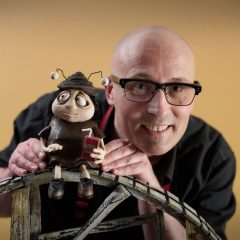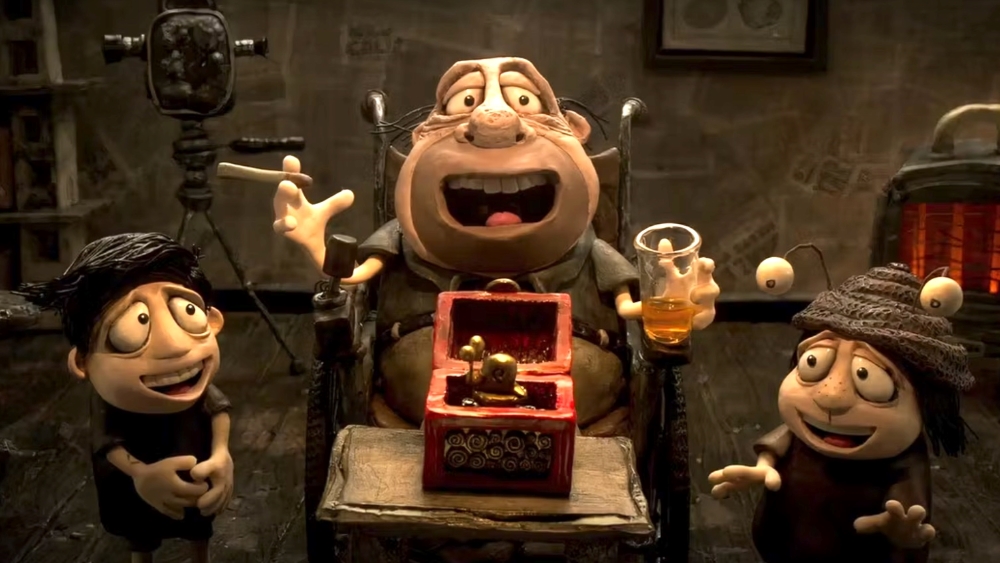|
Getting your Trinity Audio player ready...
|
Almost 15 years after Mary and Max, Australian stop-motion artist Adam Elliot has made a striking return to feature film directing with Memoir of a Snail. He hasn’t missed a step. Memoir is a tactile and touching study of loneliness. The talented artist, who won an Oscar in 2004 for his short Harvie Krumpet, picked up Annecy Festival’s Cristal for Best Feature for his latest effort, with more accolades sure to follow. We recently spoke to Elliot about working traditionally in the digital age and finding creativity out of limitation.

Animation Magazine: How did it feel to return to feature work after some time away?
Adam Elliot: I certainly had forgotten a lot of things. I felt like I was almost back to square one, and the technology had changed, the software had changed. Dragonframe didn’t exist when we made Mary and Max, LED Lights hadn’t really evolved, digital cameras have certainly improved dramatically. So there was a lot for me to quickly learn. I remember years ago, Nick Park talked about making his first feature film, Chicken Run, and that it was like being creative with a gun at your head, and you do feel that pressure constantly. And there’s a lot of money at stake, so you have this enormous sense of responsibility to produce something that works, and yet every day you fear that that’s not going to happen. You’re doing that for 18 months to two years, with this constant fear of failure that keeps you going. But we’re lucky. I really feel a huge sense of relief that this new film is working. It is certainly challenging to some sectors of the viewership, but that’s good. I want people to be challenged; the last thing I want is apathy or indifference.
You’ve said that your stories are quite reflective of the people around you. Who inspired Memoir?
Yes. So, Mary and Max is based on my real pen pal. He’s dying at the moment, and I’m going to try and get to America before he passes. Memoir is based on two people: My mother — she’s not an extreme hoarder, but she certainly collects a lot of stuff — and also a friend of mine who was born with a severe cleft palate, and I wanted to combine their two stories together.
So, I did a lot of research on the psychology of hoarding, and I realized that extreme hoarders have suffered a lot of trauma in their life. And also: When does a collection become a hoard? Often it’s when shame kicks in, and that these collections are very shameful to them and they don’t like people coming into their homes, but it is often triggered by the loss of a child or a sibling or a twin. Since everything that they accumulate has a sentimental value and they just can’t bear to let go of them, it becomes torturous. So they just accumulate and it makes them unhappier and more dysfunctional.
The asymmetrical designs of the characters in Memoir of a Snail are captivating. Can you talk me through them a little?
I find it funny because my whole life I’ve been trying to draw a straight line and never been able to. At the age of 52, it’s like, “Oh, whatever. It’s a wobbly line, just embrace your imperfections,” which is what I’m trying to say in all my films. And I’ve got to practice what I preach, and I think I’m slowly learning to not be embarrassed by my animation. Certain scenes I think, “Oh, I wish we could have redone that one.” But you’ve got to learn to let go. I mean, even the best portrait painters know that there’s always something that’s not quite right, a brush stroke that is a bit wrong. I think age makes you learn that you can try your best, and that’s as good as you can hope for.
There’s a lot of props in this film, even just in the opening title sequence alone. How many did you make for the film? What materials were you using?
I think someone did the math. There’s 200 characters (that includes animals and insects), 200 sets or locations and we are guessing somewhere between 5,000 and 7,000 props. It was very ambitious, considering our budget was very low: 7 million Australian dollars. There was a real challenge to work out how to make all this stuff but still have high production values. So we abandoned a lot of things [like] air brushes, so everything is hand-brushed, hand-painted. There’s no fabric; all the characters clothes are either painted on or sculpted on.
The other thing we did was just go back to very four basic elements to the film, which were clay, wire, paper and paint. We used other materials, but they were the four primary ingredients to the film, and that’s what kept it at that sort of very rough around the edges.

I was also a bit worried, too. Mary and Max started to get a bit too refined for my own liking, and I didn’t like the way certain scenes were heading with it, so this time I really wanted to return to the aesthetic of my short films, just that sort of more grungy, textured look, really celebrate the brush strokes and the lumpiness, just to say to the audience right from the get-go, “This is not CGI.” Again, which is why we use cellophane for fire and cotton wool for smoke and glycerin for the tears. We could have done those visual effects elements digitally, but we thought, “We’ll do it the old-fashioned way.”
But also, with AI on the horizon … I feel like the pendulum has swung back to handcraft a lot more, I think that’s just a sort of reaction to the amount of digital imagery that we’re all exposed to. So, I think stop motion’s in a very healthy state, maybe even a renaissance. You just see directors like Guillermo del Toro and Wes Anderson — they’re all dabbling in stop motion because there’s an appreciation for it.
You mentioned Mary and Max. Was there any overlap with returning collaborators working on Memoir?
We had the same cinematographer, Gerald Thompson, who’s a genius. He’s just got this incredible brain when it comes to technology and also lighting, and he’s a huge film buff himself. Two of the animators, a couple of the art department. There was a bit of a crossover. A lot of them have retired or moved overseas. So it’s continually a challenge to find good animators. And here in Australia, because my films are funded by the government, there’s a mandate to employ local talent. So we weren’t allowed to import any; we had to find them all locally. Luckily, we did. So certainly they don’t have the experience of, say, Aardman animators, but it didn’t matter too much because, again, my style is very clunky anyway. One of the animators, Nelson, he’d only graduated from film school a year or two years earlier. He suddenly got dropped in the deep end and had to animate for his life. But he was wonderful.
I’m recalling that Nick Park line about having a gun to your head.
Constant pressure. But some people work brilliantly under pressure and you get some incredible results. I think there’s a tendency in animation to spend too much time in preproduction. We don’t have that luxury; we have to get it right the first time. And that pressure sometimes doesn’t work — sometimes it’s a disaster. But more often than not, you do get some great results. And you get animation that’s a little bit more spontaneous and improvised. We love happy accidents and serendipitous moments where the character’s ear might drop off halfway through his shot, so the animator has to quickly turn the character’s head and keep animating. And sometimes the result is something funnier or weirder.
That feels appropriate for a film so invested in exploring anxiety and body image.
Oh yeah. We experimented with magnets on the film. There’s a lot of magnets and the pupils are magnets and a lot of the arms are floating magnets. But that was in many cases a disaster. There was no going back. We just had to stick with these techniques that we developed. Again, a lot of them were just invented as we were animating. Look, would I like more money and more time to make my films? Absolutely. Every film I’ve made, I feel like there’s been compromises and things I think, “Oh, if only we’d had a proper camera or a proper light or if only the characters had legs,” because in this film, the characters are sort of when they walk, they’re like the Muppets. And that’s because we didn’t have the time or the money to do proper walking and seeing their legs. I just look at budgets Laika and Aardman have and I think, “Oh, God, if I could only have half of their budgets, I’d be thrilled. [Laughs] Maybe on the next one!
Now I’m wondering what your third feature is going to look like!
I want to do a road film. I want to get away from people stuck in their houses. I want a character who goes on a long journey. I mean, easier said than done. I’ve now got to try and raise millions and millions of dollars, but hopefully this film, Memoir, will hopefully open doors to more investment, and we’ll see.
Memoir of a Snail will be released by IFC Films in the U.S. on October 25.
Australian auteur Adam Elliot shared some of his early character sketches for Memoir of a Snail with Animation Magazine. The acclaimed director is best known for his 2003 Oscar-winning short Harvie Krumpet and 2009 Annecy Cristal-winning feature Mary and Max.












 Win a Funko X Lilo & Stitch Prize Pack!
Win a Funko X Lilo & Stitch Prize Pack!

